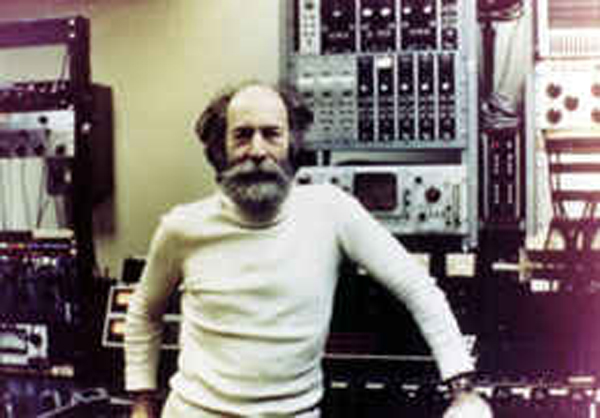Today, May 15, 2020, would be the 95th birthday of my father, Emmanuel Ghent. As I was thinking about my father, his music and his life, I remembered an interview we did – more like an informal discussion – back in 1987 in his music studio in our loft. I found the interview in an old text document this morning and am posting it in his memory.
I hope to expand upon this interview in the coming months, especially as our discussion refers to charts and some of his electronic music compositions we listened to, pieces which were created on the GROOVE system at Bell Labs.
* * *
The GROOVE System:
AN INTERVIEW WITH EMMANUEL GHENT
by Valerie Ghent, 1987
The early days of computer/electronic music are often forgotten by most of us who have come of age in this time of instant patch selection, internal signal processing and even the basic midi connection. As in any field, research and experimentation was the focus for many of the original explorers. There were countless people who gave years of their lives in pursuit of what then was just edging out of the theoretical: the use of computers in music. Emmanuel Ghent, my father, was one of those early computer music pioneers.
Some of the major contributors to the development of computer music worked at Bell Laboratories in Murray Hill, New Jersey. Headed by Max Mathews, the acoustic research department at Bell Labs supported various programs for composers and computer programmers (the two were not mutually exclusive then, as they most certainly are not now). Max invited Emmanuel Ghent, Laurie Spiegel, Ken Knowlton, F. Richard Moore and other pioneering composers and artists to use the powerful computers at Bell Labs in the evenings and on weekends, when they were not being used. Renowned composer Jean Claude Risset, a long-time family friend, also created music at Bell Labs (read more about Bell Labs HERE).
One area of this research is still a challenge today: the use of computers for interactive, real-time performance. With the development of software like Jam Factory, M, and Music Mouse, this challenge is being met by many composers today. But where did the foundations for these sophisticated software packages come from?
What was the basis for the ideas, the items that now appear as functions on a pull-down menu?
In search of answers to some of these questions, this writer did not have to look too far. My father, Emmanuel Ghent, worked extensively out at Bell Labs on the GROOVE system, in use at Bell from 1968 to 1979, a “digital/analog hybrid” computer system. GROOVE was an acronym for Generating Realtime Operations On Voltage-controlled Equipment. The GROOVE system utilized the analog domain for synthesis, but retained the advantages of digital control and digital storage (for scores). Ghent produced compositions in an interactive environment, where after programming the computer to generate ideas according to certain guidelines (some algorithmic in nature), the human composer could use real-time feedback (via knobs, switches, touch plates and buttons) to control his or her compositional decisions.
Fascinated by this work from the age of ten, when I made my first journey out to Bell Labs with my father, I was inspired to pursue more information about an area of research which seems to have been overlooked. One afternoon in 1987, I began searching for the background of technology that I have always taken for granted. This started as a discussion, an informal interview with my father. After only two hours in his New York studio I found myself overwhelmed with information.
Not only did my father provide answers to some of my questions, but we listened to examples of various compositions, and looked at both scores and charts of various algorithmic guidelines that he used while composing. We also examined some antique pieces of equipment which he invented to synchronize live performers with tape (the coordinome, and its predecessor, the polynome). I left with more questions than I had when I arrived.
The following is a selection from our conversation that day in his studio:
Emmanuel Ghent on Bell Labs, GROOVE, and Early Electronic Music Composition
Valerie Ghent: What was the basis for your work, your compositions, out at Bell Labs? And wasn’t the idea of creating a computer program to compose music disturbing to people at that time?
Dr. Emmanuel Ghent: We were doing all sorts of experimenting with what kinds of sounds we could make and how to control them. I think the first piece I wrote there (at Bell Labs) was using African drumming rhythms. It was called Battery Park. It’s based on standard African rhythms, except that the pitches of the drums are changing. Also, around that time I wrote a piece for violin called Helices. A lot of it was made on a kind of semi-random basis, where you could turn dials and change events within the piece. It was not very well controlled. But to come up to where I began getting the computer to compose, that comes up a few years later.
Valerie Ghent (VG): So basically it took a couple of years. In 1968, you went to Max (Mathews) out at Bell, and then started writing your programs on the GROOVE system.
Emmanul Ghent (EG): Well, by 1969 we were using it (GROOVE). Battery Park was done in 1969.
Valerie Ghent (VG): So there was a lot of experimentation with sound and what you could do with it. I suppose this had to happen before you could really use the system.
Emmanuel Ghent (EG): Yes, that’s right. And in 1969, Helices was written. In 1970 I started working with some electronic circuits that Max had built, which made drumlike sounds. He called them resonants.
VG: The first drum machine.
EG: Well, yes, they were very nice drum sounds. I used those to write a piece called Phosphones. At the same time it occurred to me that if we could use the computer to make music, if we had some way of translating the what are called ‘functions of time’, into some way of controlling theatrical lights, we could also control the lighting. Synchronize them. So that’s when Jimmy (Seawright) and I got the idea of “Hey, maybe we could even get the GROOVE program to also punch out paper tape which we could hook up to this old machine over here…” (the coordinome, invented by Ghent, described earlier in the discussion).
VG: Which could trigger the lights.
EG: Which could trigger the lights, and not only trigger them, but trigger them in terms of programming their intensity. Anyhow, to come up to more recent things. Somewhere around 1974, I began working in a different way. I began trying to get the computer to do the composing. There are two stages to that. The first stage, I thought, would be that if I’m going to get the computer to do some composing, I better make the music simple enough so that I could be able to understand what the computer was doing. If I make it so complicated, I wouldn’t know what the computer was doing even if it was doing brilliant things. As I turned the knobs I wouldn’t be able to control it. So, what I thought I would do, is to get the computer to make some musical lines that were tonal, because tonal lines, like real tunes, would be easy to follow. So if it made changes in them, I would hear what the changes were, and that way I would know what did what.
VG: What was the first step in this process?
EG: The first step was to get the computer – keep in mind that this is all the first kind of using the computer – to compose. The second kind I’ll talk about later, that was more complex. But this first kind, what I did was get the computer – using some random functions – to make some tunes. I did this by giving the computer a set of pitches that were fairly heavily weighted in favour of the key of Bb. And even though it used every pitch – except that in the key of Bb there is no augmented fourth, no E – some of them were repeated, like the Bb and the F were more common. So that it was weighted to make it come out like a real Bb key.
And then, let’s see (looks over a chart, which I have replicated in part: see last page). There, this Bb, and this F, and that Bb, and then C, Db, D natural, Eb, no E, then another F, Gb, G, Ab, A, Bb again, C and D. Those were the only pitches. And here I pulled some kind of neat tricks, I think.
VG: So there were fifteen pitches used, three Bb’s and no E.
EG: Three Bb’s, two F’s, two D’s, two C’s and no E. So it was clearly weighted in favour of a more or less tonal thing. So then, what I got the computer to do, (Ghent shifts in his chair at this point, becoming absorbed in the telling), was to make a tune by giving it different rhythms, or rather, different rhythmic probabilities, and different pitch probabilities. I’ve forgotten exactly how I did this, but let’s say I would start by telling the computer “OK, starting on the Bb, make up a tune of 47 notes, that used only quarter notes with a frequency about twice as often as half notes, or eighth notes.
VG: So you would give some kind of rhythmic ratio for the computer to work with.
EG: Just probabilities. So I didn’t know exactly which notes it was going to select, nor did I know which duration it was going to select at any given time. Well, it came up with some wonderful melodies!
I remember, one after another, tunes that were wonderful! I couldn’t believe….they were just great tunes! (laughs) And I wondered, where do these things come from? (laughs again, more heartily this time)
There were lots of them. You know, I just didn’t know which one to select! You could just sit there and listen to this computer make all –
VG: You know it makes you wonder…it really raises the philosophical question about when the “muse” comes and visits you. There are probabilities in your own head, of what tones and melodies that you unconsciously hear, and at some point –
EG: Well that was the way it was. It was as if, well, it just did what you do as a composer, but it did it according to slightly different rules. Because it doesn’t know your rules.
VG: Right, but do we know our own ‘rules’? (we both laugh together)
EG: (chuckling) Well, sometimes it was very very boring, but every so often you would program it and it would be simply wonderful – and you never quite understood what made for the difference. It would produce all these melodies that were really fascinating. And so, the first piece was practically all equal notes. (sings/hums the beginning of “Computer Brass“)
VG: What was that piece called? I’ve heard that one several times.
EG: Computer Brass. (Ghent gets up, goes around the large table which supports at least six (ancient) 2-track and 4-track tape recorders, an oscillator, and an eight channel mixer. He pulls a score off of the overloaded shelves behind the table, which run along the entire length of his studio. The shelves are packed solidly with boxes upon boxes of tapes and scores, a life’s work.) Let me play that for you now.
A pause, while we listen to the ten minute composition.
EG: It was in this piece that I used something which I called ‘translocation’, and also my own kind of ‘inversion’. I didn’t invert the notes, I inverted the numbers. Remember these notes were numbered from one to fifteen.
VG: So whatever pitch was number one inverted to fifteen, pitch two to fourteen…
EG: That’s right. But you still preserve the same frequency of pitches. Everything was just reversed in terms of which notes were going to be selected.
VG: So pitch number eight stayed the same.
EG: Eight was the same. Then, where there was a Bb before, now there would be a high D. Where there was an F, now there would be a high C, where there was a Bb up there, now there would still be a Bb, because I chose the (pitch) set in such a way that it would preserve the –
VG: How did you choose 15 to begin with? Was it random?
EG: I fiddled with it in different ways till it came out making sense to me. So when I say that kind of inversion, it’s got nothing to do with the usual inversion. The other thing I could do was translocating. It was similar to transposing, but in ordinary transposition you take a whole tone or a major third and you push the whole thing up and it’s still the same tune. Well, what I did was not transposing, but translocating: instead of adding a whole step or an interval, I added a number. So if I added one, I would be adding the number one to every note. Wherever there was a Bb before, make it an F. An F would become a Bb. (again, see last page)
VG: This reminds me of a time out at Bell Labs where we had written a letter to someone, and you showed me how to change all the letter E’s to A’s, or any other letter. Simple word processing now. Your translocation seems similar to that, except that here you are “pushing notes” over by one, or four or six. A better analogy would be asking the computer to change every letter to the one following it in the alphabet, or to the third letter in the word.
EG: That’s right. It’s something like that, so you do get strange discontinuities. Let’s say, if you were to start with a tune that went:
(sings) Eb, Bb, high F. Now, if it were inverted, it would go down, like that. (Gb, Bb, F). But if it were translocated by 12 or 13, it may end up having a huge jump in it, from this F to that low Bb, to the high D. So you are going to get whole different relations among the notes. This shows the different translocations (points at a chart similar to the I have started, but with all fourteen translocations and many other functions).
Let’s see, this is the original form over here. Now that’s the original translocated up one. The first Bb (in the pitch set described earlier) becomes the F, the second Bb becomes a C. Translocated by two, while the first Bb remains a Bb (Bb is both the first and the third pitch of the set), the second Bb becomes the C#, while the C goes up to the D. But then the second C (the fourteenth pitch), becomes a D when translocated by one, but translocated by two, it passes the end of the pitch set and has to go back again to the first pitch, which is Bb.
So now, translocated by two, that second C becomes the low Bb again (pitch number one). So translocation changes the shape altogether. In fact, some of them become actually turned around because of the placement. And then, of course, when you invert them, and you translocate them as well, you have again a whole new set of variants.
What I would do, you see, is I had the keyboard there in front of me, and when I was in that particular subprogram, by touching D it would add two, it would translocate by two. If I touched another key, it would turn the thing upside down. So in real-time I could keep switching these things all over the place, just to see what they sounded like.
VG: Imagine if you had that program now, or you had a midi capability then, so that if you played it up here, this could be assigned to one keyboard, that section assigned to another keyboard or channel, which then this translocated could be constantly…
EG: Oh now you could do fabulous things with it. Then here were some other kinds of variants (points to some new functions I’d never heard of before). That’s the original, and here are the inversions.
VG: Does this say ‘inversion 10’? All of these are numbered.
EG: Yes, that is the 10th inversion. In this piece there could be up to 14 inversions.
VG: This one is called ‘retrograde’?
EG: That would be playing the entire piece backwards, the original, backwards. Then there was retrograde inversion. (laughs) And each one of these tunes were lovely!
VG: What is ‘abstracted increment’?
EG: Oh. Well, I wondered what would happen if I were to leave out some of the notes? So I asked the computer to simply leave out every second note, or every third note. So then it plays, and then you have a whole new tune! And it still fits.
VG: Of course.
EG: And then there was, what’s that one say?
VG: As above, with ‘interpolation’.
EG: With interpolation. Now that I thought of for the slow tunes, the ones with abstracted (removed) notes. I would say, take this slow tune over here, which has every second note removed, and have the computer interpolate (from the same pitch set of 15 notes) the notes in between this one, this one and that one (points randomly to three notes on the score). Then it would add the notes in those places, and only in those places.
VG: I see.
EG: So going up from this F to that F, there would now be notes in between, it would play all of those notes.
VG: ‘Delayed’ and ‘augmented’?
EG: Oh yes. The delay means that instead of starting at a simultaneous time,
VG: It must be spread out
EG: It starts over here (points to later in the score). It starts off late. It becomes augmented in that whenever there was an eighth note, I asked the computer to make it a quarter note, just double or triple or quadruple the durations. And then, when I did that I could say now interpolate inside there, invert it, translocate it…..
VG: So the ideas kept changing and rewriting themselves.
EG: And these were just some of the variants.
To be continued…
More articles on Emmanuel Ghent:









Francis Laurent
Your father Was a genius, Valerie! You are a Genius too. Kiss you 💋🇧🇷
NelBispo
Concordo com você, Francis. Como dizemos aqui no Brasil, filho de peixe, peixinho é…rsr
NelBispo
And your father, one of the precursors of what is there today.
That is why you have someone to draw on, music has been in your veins since it was born, including the participation of your mother, violist and violinist; it was not forcibly introduced, as in many out there …
Today, anyone makes music with the help of these powerful tools, which he helped to create and develop.
Match the “Bb’s”, “Db”, “D,” and “E – F” etc, from the beginning that your father created, today we have the facilities that everyone uses around the world.
If today, we are stunned by what computers do, in terms of music, I am imagining the feeling of your father when he felt all this …
Posthumous and vivid congratulations to this musician family, in the essence of the term!
Congratulations on the above, brilliant and enlightening interview.
May he continue to rest in peace and smile, forever!
LUCIANO
I forgot to tell you that I will understand if your commitments, which I hope are prolific for you, do not allow you to fulfil my requests.Take care